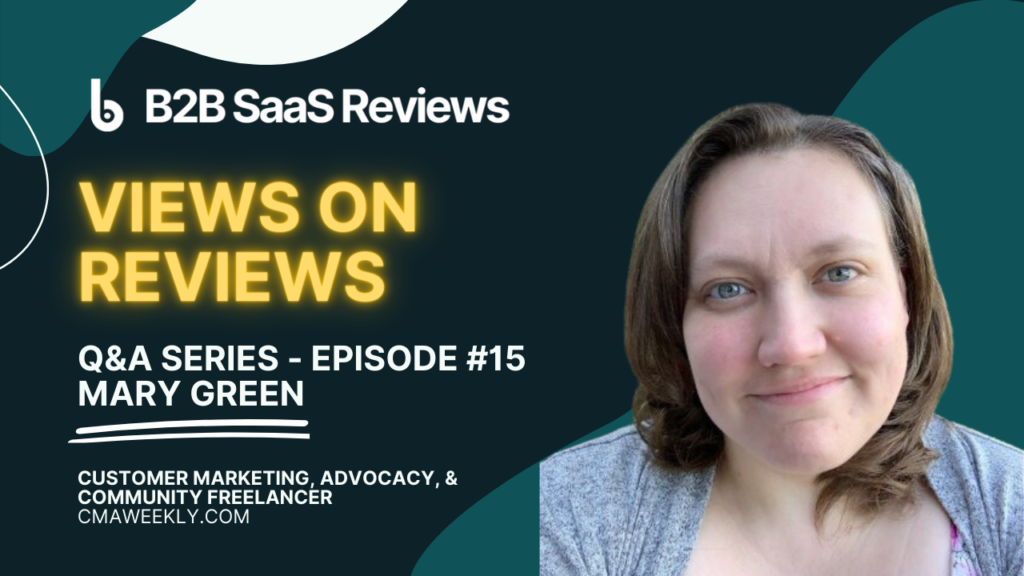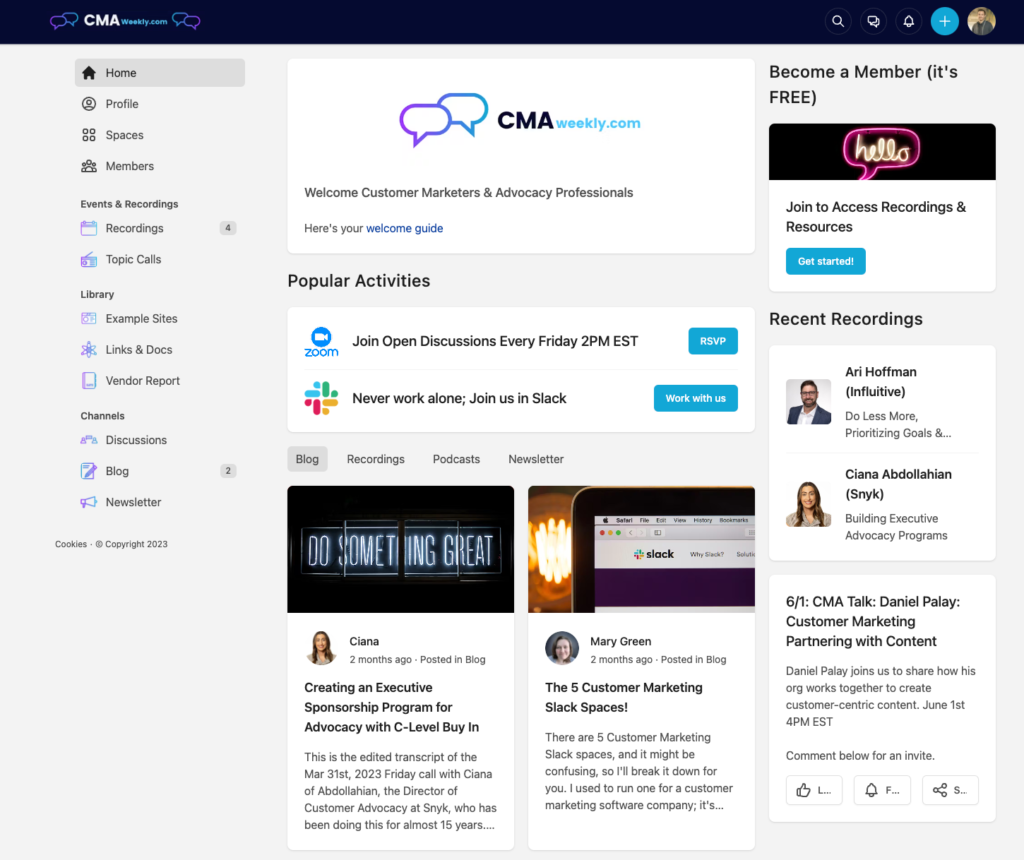Views on Reviews is a series of interviews with B2B SaaS professionals who provide a real-world perspective on what it’s like working on reviews. The fifteenth interview is with Mary Green, Leader of the CMAweekly community. In it, we cover the role of community in customer advocacy and, of course, reviews.

Mary Green is a community builder.
She’s also a leading Customer Marketing & Community Advisor who’s helped HubSpot, Forbes, Outreach/SalesHacker, and Demandbase create communities that have transformed their businesses & industries.
These communities have grown exponentially (HubSpot from 40k to 154k), raised 100’s of 1,000’s in sponsor fees (Sales Hacker), increased traffic, customer valuation, program and live event attendance (Forbes), and influenced 1,000,000s in revenue (Demandbase: Magic Quadrant Leader.)
She also leads the CMAweekly, arguably the most engaged Customer Marketing & Advocacy professionals community.
I’m grateful she took the time to share her review views. Here they are:
Key Takeaways On Customer Communities, Advocacy & Reviews
To measure the ROI of reviews, here are the from Mary:
- Communities make it easy to find customers that want to interact more closely with your brand.
- CMA professionals generally wish it was easier to get reviews, know which review sites to get them on, and be free to ask whom they like for a review.
- Ask for reviews in an advocate or customer newsletter. Ask once per month to balance the need for more reviews and limit the number of times you ask.
- When starting with review collection, you’ll need immediate outreach to as many customers as possible. Once you have the reviews you need, you can shift to a long-term, sustainable approach to review collection.
- Use multiple channels to ask for reviews: use a tool like Pendo to find your customers who use your product a lot and ask them for reviews. Ask graduates from your academy/education program to leave reviews. Ask your community of advocates. Ask your Customer Success team and Executives to contact their customer contacts for a review.
- Ask for reviews on multiple channels: (1:1) email (short and text-only work best), direct message, Slack, etc.
- Offer a creative incentive for a review that gets attention and has a unique perspective. E.g. leave a review, and we’ll sponsor a dog at Best Friends shelter for two months.
- Segment your advocates to send more personalized messages to increase their acts of advocacy while strengthening your relationships through better communication.
- Look at the data you have on where your customers go for reviews, stay on top of key requirements of those review sites, and adjust your asks accordingly.
Q&A with Mary Green
Here’s the full interview with Mary.
Hey Mary 👋 On your LinkedIn profile, you say that communities can “get all of the reviews, references, testimonials, and speakers you'll ever need.” Can you elaborate on why communities can be such an effective way to get reviews?
Communities make it easy to find the customers that want to interact more closely with your brand. Laura Ramos of Forrester talks about the 4 types of advocates that join a community (calling those that join a community an advocate). From there, it’s really about segmenting the customers based on how they want to participate and making sure they get the option to do so.
Since communities create engagement and content you can quickly find customers that want to share, then introduce them to the option of taking on advocacy opportunities like leaving reviews, being a reference, or sharing their testimonial.
You speak to many CMA professionals. What are the top 1-3 things that you hear them say they wish were different about the state of reviews?
The top three things that I hear about reviews from the CMA community are:
- They wish it was easier to get their a lot of customers to leave reviews ASAP
- Their company only allows them to offer certain customers the option to leave a review
- They often aren’t sure what review site is the best place to have customers leave reviews.
What’s your favorite review sourcing example?
I’d say my favorite way to drive reviews is to use an advocate or customer newsletter. When I can share the opportunity from time to time (say 1x/mo), it’s seen as less intrusive, more people are interested (because it isn’t always available) and it produces great results.
As the Director of Community Programs & Advocacy at Demandbase, you led the reviews collection that helped earn the top position in the Gartner Magic Quadrant for ABM. How did you source reviews?
In several ways: we ran reports in Pendo to find customers who used the product a lot. We asked Academy graduates to leave reviews. I built a community of advocates and often run campaigns to get them to participate in leaving a review. We asked Customer Success and Executives to reach out to contacts and ask them to leave reviews.
In your CMAweekly community, you organize weekly calls. In the call on reviews and references, you mentioned that there seems to be two way to go about it: through a customer advocacy program (the way you know it) or random acts of advocacy ( some exec says, we need reviews and someone, often a customer marketers, has to find a way to get them). Can you tell us what you’ve seen from these two approaches?
At the beginning of your work for reviews, you will need a lot of good reviews quickly. In this case, you have to look at it as pulling from the strategy of random advocacy. It’s immediate outreach to as many customers that seem happy as possible.
Once you’ve hit the numbers you need, you have to think more strategically for the long-term approach. You certainly don’t want to have to scramble again in the near future (though many will).
Here, you want to include asking for reviews more regularly through your advocacy program, maybe in Influitive, in your customer or advocate newsletter, throughout the lifecycle, and in various pieces of content.
Note: here’s the CMAweekly call recording on reviews and references.
In the CMAweekly call on reviews and references, you said that you don’t think CMA professionals use segmentation enough. Why is that, and how can they use it more?
CMA professionals get access to a lot of data they often don’t track and it’s extremely helpful in helping you decide who, when, and how to ask customers to participate in advocacy in the future.
Does someone have a new job? Does someone like to educate other advocates? Do they prefer access to exclusive content instead of monetary rewards? Are they travelling for a couple of weeks? What activities have they completed before?
You can normalize this data in a spreadsheet or CRM and pull reports before sending emails to all customers or advocates. When you do this, you are likely to get dozens of customers in different cohorts. Now you can send a personalized message to each group, include your ask, but make the communication feel more personal and intimate.
Note: here’s the CMAweekly call recording on reviews and references.
One of the first threads in the CMAweekly Slack channel was on reviews. As a refresher, you shared this anonymous post: "New boss wants me to add PeerSpot to my GPI and TrustRadius review sourcing. How do I do this without overwhelming my customers?" What’s your view of how to source reviews across multiple review sites?

Look at the data you have: are a lot of prospects coming from 1 site? Are they purchasing more than others? What sites are your competitors active on?
From there, rally your advocates; the status seeker career customers that want the opportunity to build their career and the validators that often leave reviews. Ask them to complete reviews on the sites where they haven’t left reviews previously.
I recommend staying on top of the number of reviews you have, any requirements those review sites have, and adjusting your ask campaigns based on where you need the reviews most.
Then building ongoing asks along the lifecycle for the future, measuring how that works, and adjusting accordingly.
You kindly shared my post on How to Respond to Reviews, which had CMA input thanks to your CMAWeekly community. What’s your view (and/or experience) on responding to reviews?
Responding to reviews is never easy for the company or the professional tasked with doing it. We all put a lot of effort into our work, and have close emotional ties to our work. When it comes to responding to reviews we get defensive, we want to fix it but often feel insulted and want to blame the customer (sometimes it is a user error issue).
BUT, the public, the industries, and most important, prospects and customers do NOT appreciate this approach. You have to respond with a message acknowledging the issue and taking responsibility in fixing it, without making it sound like someone else is to blame. It’s tough, but no other response is really appropriate or will be seen as favorable by others.
Note: here’s a link to the post, How to Respond to Reviews.
You surveyed 153 Customer Marketers & Advocacy professionals for their input on vendor & tool feedback. 92 of them share feedback about vendors specific to our space. What sparked your interest in surveying CMA professionals on the CMA software they use?
I speak to a lot of people who ask what tool/program they should use for their new advocacy, community, or reference programs. Knowing that a lot of people use these tools, I wanted to understand who was happy with their tool of choice so that I could share it with others in the industry.
Note: here are the results from the CMAweekly Vendor Satisfaction report.
What were the main findings of the survey report?
Interesting findings included:
- A lot of customer marketers and advocacy professionals use multiple tools, almost all of us use spreadsheets in some way.
- The legacy tools in our space — Influitive and Reference Edge — have pretty happy customers, which I think shows they understand the space well.
- Newer tools in the space have far fewer customers but higher scores. This is true for Orca, SlapFive, and UserEvidence.
- Finally, two companies in the space have very unhappy customers, and this feedback helps potential customers better understand the risks of choosing these tools.
Bonus Questions 🎁
What drew you to a career in Customer Marketing?
I love working with customers and helping them succeed in their roles.
What functions do you see involved in reviews, and what is their role?
- Customer marketing for driving customers to leave reviews.
- Customer success is often involved because they already have close relationships with customers and CMs do not.
- Sales often have a lot of relationships they can leverage for reviews.
- Community managers have access to many stories and close relationships with customers.
- Customer education can easily indicate if a customer is likely to become an advocate based on their participation in courses which easily shows they are interested in achieving success.
What have you found works—and what doesn't—in review generation (when asking for reviews)?
Short, text-only messages in email, direct message, and Slack. Then a creative incentive that gets attention and has a unique perspective. Like; Leave a review, and we’ll sponsor a dog at Best Friends shelter for 2 months.
Next Steps to Learn More
Follow Mary on LinkedIn to get more of her takes on customer marketing and advocacy. Also:
- Join the CMAweekly Community
- Subscribe to the newsletter, CMAweekly industry news
- Read Mary’s guide, How to Scale Your Advocacy Program
Authors
-

I'm the Founder and Editor-In-Chief of B2B SaaS Reviews and the Director of Demand Generation at PartnerStack, the leading platform for partner management and affiliate marketing in B2B SaaS. My experience spans several notable B2B SaaS companies, including Influitive (Advocate Marketing), LevelJump (Sales Enablement, acquired by Salesforce), and Eloqua (Marketing Automation, acquired by Oracle). I hold a Bachelor of Commerce in Marketing Management from Toronto Metropolitan University and a Master of International Business from Queen's University, with academic exchanges at Copenhagen Business School and Bocconi University.
-







